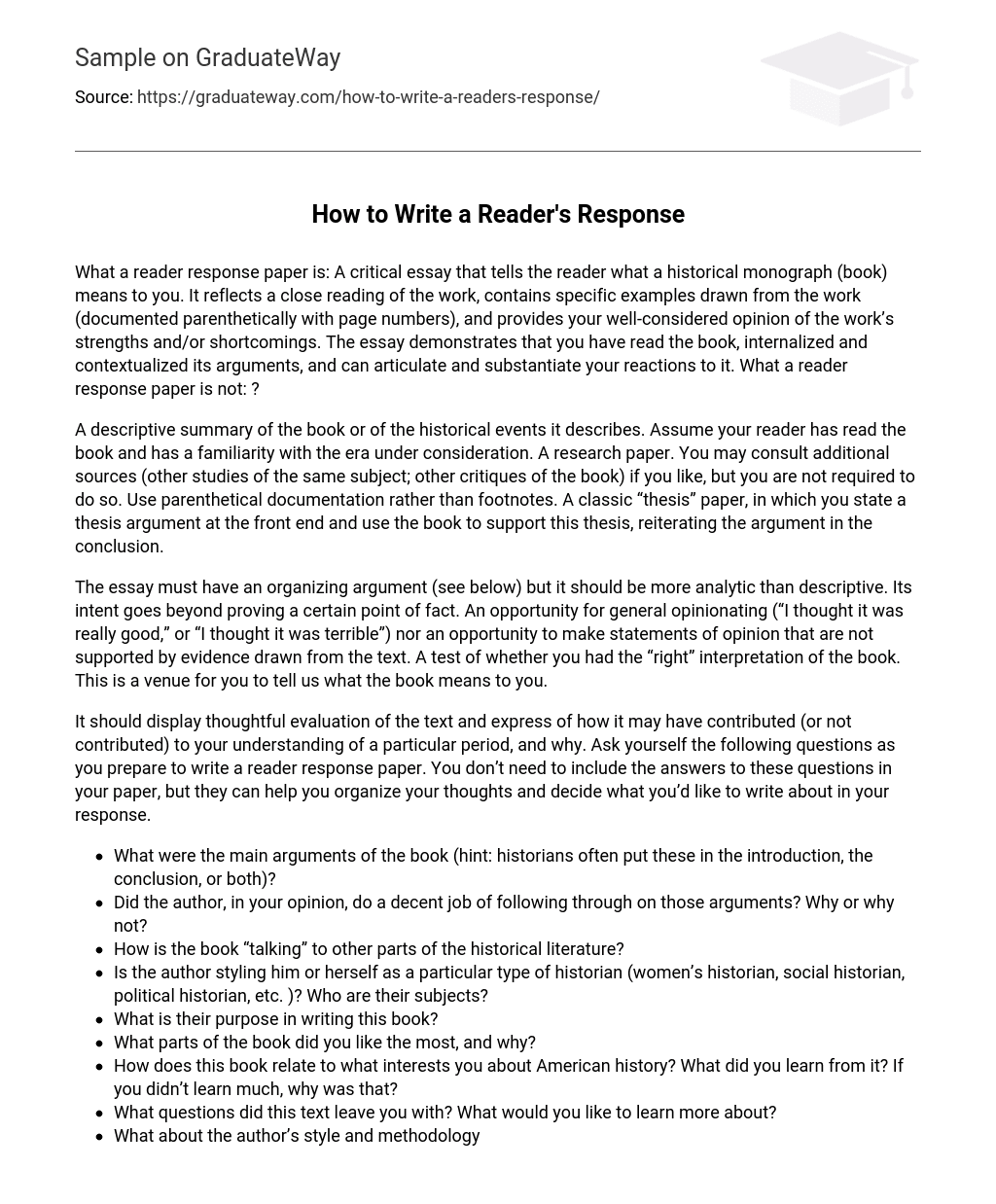What a reader response paper is: A critical essay that tells the reader what a historical monograph (book) means to you. It reflects a close reading of the work, contains specific examples drawn from the work (documented parenthetically with page numbers), and provides your well-considered opinion of the work’s strengths and/or shortcomings. The essay demonstrates that you have read the book, internalized and contextualized its arguments, and can articulate and substantiate your reactions to it. What a reader response paper is not: ?
A descriptive summary of the book or of the historical events it describes. Assume your reader has read the book and has a familiarity with the era under consideration. A research paper. You may consult additional sources (other studies of the same subject; other critiques of the book) if you like, but you are not required to do so. Use parenthetical documentation rather than footnotes. A classic “thesis” paper, in which you state a thesis argument at the front end and use the book to support this thesis, reiterating the argument in the conclusion.
The essay must have an organizing argument (see below) but it should be more analytic than descriptive. Its intent goes beyond proving a certain point of fact. An opportunity for general opinionating (“I thought it was really good,” or “I thought it was terrible”) nor an opportunity to make statements of opinion that are not supported by evidence drawn from the text. A test of whether you had the “right” interpretation of the book. This is a venue for you to tell us what the book means to you.
It should display thoughtful evaluation of the text and express of how it may have contributed (or not contributed) to your understanding of a particular period, and why. Ask yourself the following questions as you prepare to write a reader response paper. You don’t need to include the answers to these questions in your paper, but they can help you organize your thoughts and decide what you’d like to write about in your response.
- What were the main arguments of the book (hint: historians often put these in the introduction, the conclusion, or both)?
- Did the author, in your opinion, do a decent job of following through on those arguments? Why or why not?
- How is the book “talking” to other parts of the historical literature?
- Is the author styling him or herself as a particular type of historian (women’s historian, social historian, political historian, etc. )? Who are their subjects?
- What is their purpose in writing this book?
- What parts of the book did you like the most, and why?
- How does this book relate to what interests you about American history? What did you learn from it? If you didn’t learn much, why was that?
- What questions did this text leave you with? What would you like to learn more about?
- What about the author’s style and methodology did you like or dislike?
- How are they using sources and how does this reflect on the integrity and validity of their arguments?
For useful things to keep in mind as you read the book, consult “How to Read a Secondary Source” in Prof. Patrick Rael’s Writing Guide (you can link to it from the “Studying and Teaching History” page on my website and also directly at http://www. bowdoin. edu/writing-guides/). Sample format for a reader response paper of 4-5 pages:
- Introduction/theme: 1-2 paragraphs that “set the stage” for what will follow. Possible entry points include: a broader trend that interests you in American history and how this book’s contents explain it; another book (or school of thought) that this book either supports or refutes; assumptions or opinions you hold that this book might challenge.
- Background: 2-3 paragraphs that introduce the book, its main arguments and context in which it was written, and place the text in its historiographic context (i. e. , how it relates to other literature on the subject).
- Analysis: use the remainder of the paper to hone in on a certain element of the book and provide your opinion of it. This, as much as anything, is the “thesis” of this essay. You may choose to focus on the main argument of the book, or just one element of the book (for example, the author’s treatment of gender, or the author’s conclusions about the durability of third parties, or the author’s style and research methodology). The analysis should contain direct quotes or paraphrased examples from the book (all cited with page numbers) to support your argument.
- Conclusion: one paragraph that brings us back to your entering statement and states the wider significance of this work to you, and to the literature. And, as you write, do not forget the basic rules of style and grammar. See my handout “Some guidelines for writing American history papers” (http://faculty. washington. edu/momara/Paper%20Guidelines. pdf). To understand and interpret the grade you receive on a paper or other assignment, also consult my grading standards (http://faculty. washington. edu/momara/Grading%20Standards. pdf).





